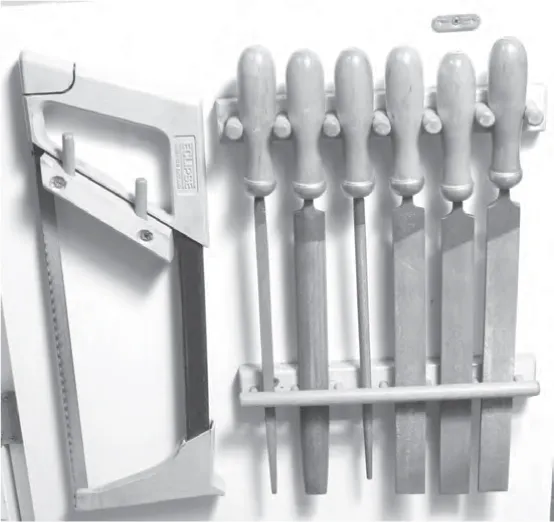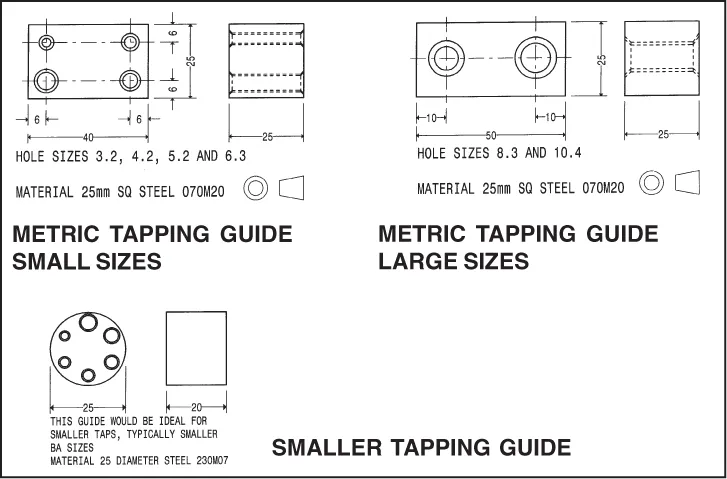
eBook - ePub
16 Metalworking Workshop Projects for Home Machinists
Practical & Useful Ideas for the Small Shop
Harold Hall
This is a test
- 250 Seiten
- English
- ePUB (handyfreundlich)
- Über iOS und Android verfügbar
eBook - ePub
16 Metalworking Workshop Projects for Home Machinists
Practical & Useful Ideas for the Small Shop
Harold Hall
Angaben zum Buch
Buchvorschau
Inhaltsverzeichnis
Quellenangaben
Über dieses Buch
Create useful and essential items that can't be purchased commercially, from an auxiliary workbench and tap holders to distance and height gauges, a lathe backstop, faceplate clamps, and so much more. 16 Metalworking Workshop Projects for Home Machinists contains a collection of unique projects based on the author's most popular articles that have been published in Model Engineer's Workshop magazine. Every project is intended to make workshop tasks easier once the item is completed and ready for use.
Häufig gestellte Fragen
Wie kann ich mein Abo kündigen?
Gehe einfach zum Kontobereich in den Einstellungen und klicke auf „Abo kündigen“ – ganz einfach. Nachdem du gekündigt hast, bleibt deine Mitgliedschaft für den verbleibenden Abozeitraum, den du bereits bezahlt hast, aktiv. Mehr Informationen hier.
(Wie) Kann ich Bücher herunterladen?
Derzeit stehen all unsere auf Mobilgeräte reagierenden ePub-Bücher zum Download über die App zur Verfügung. Die meisten unserer PDFs stehen ebenfalls zum Download bereit; wir arbeiten daran, auch die übrigen PDFs zum Download anzubieten, bei denen dies aktuell noch nicht möglich ist. Weitere Informationen hier.
Welcher Unterschied besteht bei den Preisen zwischen den Aboplänen?
Mit beiden Aboplänen erhältst du vollen Zugang zur Bibliothek und allen Funktionen von Perlego. Die einzigen Unterschiede bestehen im Preis und dem Abozeitraum: Mit dem Jahresabo sparst du auf 12 Monate gerechnet im Vergleich zum Monatsabo rund 30 %.
Was ist Perlego?
Wir sind ein Online-Abodienst für Lehrbücher, bei dem du für weniger als den Preis eines einzelnen Buches pro Monat Zugang zu einer ganzen Online-Bibliothek erhältst. Mit über 1 Million Büchern zu über 1.000 verschiedenen Themen haben wir bestimmt alles, was du brauchst! Weitere Informationen hier.
Unterstützt Perlego Text-zu-Sprache?
Achte auf das Symbol zum Vorlesen in deinem nächsten Buch, um zu sehen, ob du es dir auch anhören kannst. Bei diesem Tool wird dir Text laut vorgelesen, wobei der Text beim Vorlesen auch grafisch hervorgehoben wird. Du kannst das Vorlesen jederzeit anhalten, beschleunigen und verlangsamen. Weitere Informationen hier.
Ist 16 Metalworking Workshop Projects for Home Machinists als Online-PDF/ePub verfügbar?
Ja, du hast Zugang zu 16 Metalworking Workshop Projects for Home Machinists von Harold Hall im PDF- und/oder ePub-Format sowie zu anderen beliebten Büchern aus Technik & Maschinenbau & Technische & produzierende Gewerbe. Aus unserem Katalog stehen dir über 1 Million Bücher zur Verfügung.
Information
Chapter 1
Auxiliary Bench
This is the simplest of all the items included and without doubt the one that has repaid my time making it by more times over than any other. It is an auxiliary workbench and took me around 15 minutes to make. I did though have a suitable size piece of ply available for the top, but even if you have to cut the top to size 1 hour should be more than enough.
The bench was initially conceived for holding pieces of sheet steel for cutting using a jig saw, nibbler, etc. This was something I found difficult using my normal bench with it having only one edge available, resulting in clamps and saw wanting to share the same position. The bench, Photo 1, is about 450mm square and has a 75mm × 50mm piece of timber screwed onto the under side which is gripped in the bench vise. Photo 2, shows it being used for it original purpose.

Photo 1 An auxiliary bench with a multitude of uses

Photo 2. Being used to hold a sheet of metal while it is being cut using a jig saw.
I soon realized that in its elevated position it was also of considerable benefit when marking out, similarly, carrying out delicate assembly work, electronic or mechanical. If you have a small workshop with only limited bench space it will be a worthwhile addition if only to increase your working space, maybe larger may not be a bad idea.
If a long bolt is added to the timber bar this can be gripped in the bench vise and the top tilted to make a small drawing board, Photo 3.
File storage
While in a woodworking theme, the method of storing files on the rear of a cupboard door, Photo 4, is worth considering. It keeps them in the same place all the time so they are easily found and by keeping them apart protects their working faces. Sketch 1 shows the construction in detail. If mounted on a wall rather than on the rear of a door then the lower half could possibly be omitted.
Chuck boards
These were the result of a request from a workshop owner who was beginning to find it difficult to move his lathe chucks to and from the lathe. Additionally, aligning them with the lathe’s mandrel.
Photo 5 shows two boards, one for the three jaw and one for the four jaw. These are used on a gap bed lathe and the piece of wood in front is for placing in the gap to prevent the board tipping with the weight of the chuck. Note how the carrying handles pass in front and behind the chuck ensuring they are secure when being carried.

Photo 3 Used tilted it makes a small drawing board for use in the workshop.

Photo 4 A method of supporting files on the rear of a cupboard door.

Photo 5 These chuck boards make carrying the chucks to and from the lathe an easier operation. Also, while on the lathe’s bed they protect the bed from accidents and holding the chuck at center height assists in fitting them to the lathe’s mandrel.
To make the board place it against the chuck while fitted to the lathe and mark its edge with the shape of the chuck. Start chiseling out the shape, frequently checking it for a close fit under the chuck. The ease of screwing the three jaw chuck onto the lathe’s mandrel is further enhanced by placing a long length of rod in the chuck and loosely closing the drill chucks jaws onto the other end. This will align the chuck with the mandrel making the process a simple one.
Having started with a woodworking theme, in the next chapter we get down to the real purpose of the book, metalworking!

Chapter 2
Tapping Guides
Hand tapping into metal components would at first appear to be a problem free task. This providing the correct tapping size hole has been prepared as an unnecessarily small hole is often the reason for a broken tap!
Attempting the task though it will soon be found not to be as easy as first thought. The main problem is getting the tap to enter in line with the hole’s axis. To achieve this it requires the tap to be viewed in two planes, often not that easy. At best the tapped hole may present a problem when the parts are assembled as a tilted screw attempts to pass through a perpendicular clearance hole. With a number of fixings, assembly may only be possible if the clearance holes are increased in size beyond what would be considered acceptable.
This though is not the only problem, especially with small diameter taps. In this case, as the tap enters further into the hole prepared, it will begin to cut more on one side than the other. As a result, smaller size taps are more likely to be broken, even if having the correct tapping hole.

Photo 1 Three typical tapping guides.

Photo 2. For smaller sizes tapping can be carried out purely by hand.
Photo 1 show two forms of tapping guide that, while simple, almost eliminates the problems of tapping square. The tap is passed through the appropriate guide and its end located in the hole in the workpiece. With this done, the guide is held onto the workpiece using one hand while the other rotates the tap ensuring that the tapped hole is perpendicular to the surface of the component, Photo 2.
The process works well providing the tap can be rotated by a single hand, typically a maximum of 10-32, 3/16in or M5. For larger sizes though, the guide will need clamping in place, Photo 3. In this, the guide is clamped to the workpiece using a toolmakers clamp which in turn is held in the bench vise.
There will of course be some cases where the nature of the workpiece prevents these guides from being used but for most readers, I would assume they would be suitable for the vast majority of hand tapping carried out. Hardly anywhere else will so little time spent making workshop equipment be repaid so many times over in terms of the quality of the final item. I thoroughly recommend these tapping guides to you!

Photo 3. Larger size threads will need the guide to be clamped to the workpiece and held in a bench vise so that both hands are available to turn the tap.

Chapter 3
Guided Die Holder
Rather like the problem starting a tap in line with its tapping hole, as mentioned in Chapter 2, similarly, starting a die at an angle will cause the thread to go out of line with the bar on which it is being made, Photo 1. This is particularly a pr...
Inhaltsverzeichnis
Zitierstile für 16 Metalworking Workshop Projects for Home Machinists
APA 6 Citation
Hall, H. (1999). 16 Metalworking Workshop Projects for Home Machinists ([edition unavailable]). Fox Chapel Publishing. Retrieved from https://www.perlego.com/book/3178684/16-metalworking-workshop-projects-for-home-machinists-practical-useful-ideas-for-the-small-shop-pdf (Original work published 1999)
Chicago Citation
Hall, Harold. (1999) 1999. 16 Metalworking Workshop Projects for Home Machinists. [Edition unavailable]. Fox Chapel Publishing. https://www.perlego.com/book/3178684/16-metalworking-workshop-projects-for-home-machinists-practical-useful-ideas-for-the-small-shop-pdf.
Harvard Citation
Hall, H. (1999) 16 Metalworking Workshop Projects for Home Machinists. [edition unavailable]. Fox Chapel Publishing. Available at: https://www.perlego.com/book/3178684/16-metalworking-workshop-projects-for-home-machinists-practical-useful-ideas-for-the-small-shop-pdf (Accessed: 15 October 2022).
MLA 7 Citation
Hall, Harold. 16 Metalworking Workshop Projects for Home Machinists. [edition unavailable]. Fox Chapel Publishing, 1999. Web. 15 Oct. 2022.